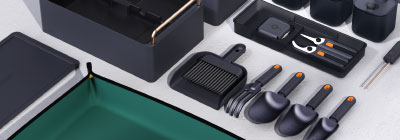
A comprehensive tool kit represents a builder's core advantage for fundamental tasks like measuring wood to driving screws with precision. This tutorial furnishes understanding to pick the right implements and employ them properly.
- Initiate your toolkit by collecting essential hand tools like a hammer, screwdrivers, wrenches, pliers, saws, and tapes.
- Become familiar with tool functionality and the unique contexts where they apply.
- Sharpen abilities via hands-on projects while steadily elevating complexity.
Remember that perfecting hand tool use boosts your craft skills. With thorough expertise, tools will enhance your capacity to deliver precise, demanding project outcomes.
Boost Project Efficiency with Power Tools
Want to boost outcomes? Enter the powerful realm of tools that combine accuracy and efficiency. These indispensable devices can reshape how you work, for pros and hobbyists alike. From high-torque drills to fine-detail saws, power tools supply varied functions to manage construction jobs easily.
- Unleash the potential of cordless impact drivers for effortless fastening and demolition.
- Learn to operate reciprocating saws for swift and tidy cutting of varied materials.
- Enhance woodworking using robust planers and jointers to attain precise smooth finishes.
Use power tools to streamline timelines and deliver remarkable project results.
Perfect Measurements Demystified
When exactness counts, proper measuring instruments shift results significantly. From classic rulers to modern laser instruments, these tools provide dependable precision for projects. Whether adept artisan or fresh hobbyist, measurement mastery opens additional creative opportunities.
- Investigate the wide selection of measuring devices catering to varied needs.
- Absorb the uses and benefits tied to every variety of measuring device.
- Develop your skills in accurate measurement and application.
Kits Tailored to Every Project
From pros to hobbyists, a correct toolkit makes all the difference in projects. From screw tightening to furniture assembly, an ideal toolset ensures accuracy and efficiency. Investigate your frequent project types to determine the best tool match.
Will a comprehensive multi-tool set be useful or is a specialized kit sufficient? With your needs defined, review brands to compare features, performance and pricing. Be sure to consult user reviews online for practical feedback prior to purchase.
With thorough review and planning, find the optimal kit that empowers confident project completion.
Maintain Your Hand Tools for Best Results
Caring for tools properly is critical for craftsmen and home builders. Ignoring maintenance causes blunt blades, damaged components and frustrating outcomes. Periodic maintenance retains tools in excellent shape and secures longevity. Start by cleaning your tools after each use to remove dirt and debris. House tools in dry conditions to prevent rust formation and corrosion.
- Use a sharpening stone or file to regularly restore blade edges.
- Lubricate moving parts with appropriate oil to reduce friction and wear.
- Inspect grips routinely for wear and substitute damaged handles as necessary.

Implementing these maintenance tips increases tool longevity and yields more rewarding project work.
Crucial Hand Tools for a Personal Workshop
A stocked home workshop offers a great space for hobbyists and DIY practitioners. Although specialized gear benefits projects, foundational hand tools are indispensable. Essential picks include a dependable hammer, an adjustable wrench and a solid tape for accurate measuring. Have an assortment of screwdrivers, capable pliers and a utility knife for cutting materials. A good quality saw will be essential for making precise cuts, and a level ensures that your work remains straight aligned even.
- Fundamental Hand Tools for Your Workshop

Power Tool Safety: A Practical Handbook
Power tools are high-powered tools that yield considerable efficiency and force. Still, these machines call for careful understanding of safety practices. Not following precautions can yield serious injury outcomes. This guide sheds light on power tool safety and provides the practices to engage responsibly.
Begin by familiarizing yourself with your tools. Read the manuals carefully, and understand the specific safety features. Always use proper PPE such as eye protection, hearing defenders and gloves. Inspect and service tools routinely to verify reliable operation.
Bear in mind safety is the top priority in any workshop environment. By following these guidelines, you can work with power tools safely and confidently.
Selecting Proper Measurement Tools for Exactness
When it comes to achieving precise measurements, the tools you select can make a significant difference. A selection of measuring instruments exists, each tailored to specific purposes. Familiarity with tool qualities supports sound selection decisions. Evaluate factors including precision, resolution and measurement method when choosing a tool.
- To measure lengths precisely, use a ruler or tape measure commonly.
- Use a protractor for indispensable angle measurements.
- Calipers are excellent tools for precise small-scale measurements.
Choosing suitable measurement instruments thoughtfully guarantees dependable accuracy.
Picking The Perfect Tool Set

Searching for the right tool set may be exciting and somewhat intimidating. As options multiply, feeling overwhelmed is understandable. This thorough resource equips you to select the perfect toolkit for your needs.
First off, determine which project types you'll commonly work on. Are you a pro or a starter? Definitive goals assist in reducing options.
- Don't be afraid to combine blend utilize both power and hand tools for a successful productive efficient outcome Use both hand and power tools together when suitable for optimal, efficient results Don't be afraid to combine blend utilize both power and hand tools for a successful productive efficient outcome
- Highlight the must-have tools
- A robust hammer and possible mallet or sledgehammer
- An adaptable collection of screwdrivers, wrenches and pliers is crucial
- Ruler, tape measure for precise measuring
- Tools for alignment: level, plumb bob, transit
Reflect on construction materials, price limits and brand trustworthiness. Understand that choosing sturdy tools is an investment over time.
DIY Tools: Simplicity and Effectiveness
Beginning DIY ventures often feels daunting. However, with correct tools and basic knowledge, even hard tasks become achievable. Initiate by getting familiar and learning tool operations. Read the manuals instructions guides carefully and practice experiment test basic operations techniques actions in a safe environment. Never forget safety is the foremost priority. Wear suitable PPE including goggles, gloves and earplugs to shield yourself.
In selecting tools, value durability and solid build quality. Invest in reliable dependable trustworthy brands that will stand the test of time last for years serve you well.
Turn to professionals or veteran DIYers at hardware stores for helpful advice. They provide useful tips and insights on selecting the most suitable tools for projects.
- Sharp tools are safer and more efficient—maintain them.
- Keep tools stored and organized to avoid misplacement and harm.
- Venture into new projects to broaden DIY experience and skills
Selecting Between Power and Hand Tools: Usage Guide
Facing a household or workshop job? Choosing power vs hand tools can pose a tricky dilemma. While power tools deliver speed and robustness, hand tools continue to be necessary for precise, delicate tasks. This breakdown helps you select the right tool type for your specific job.
- For detailed, precise work—carving, fitting, intricate fixes—hand tools are ideal. They afford better control while usually being easier on the budget.
- When projects require fast cutting, drilling or sanding, power tools markedly reduce time and effort. They significantly lower manual labor and shorten project timelines.
At the end, the optimal choice depends on project needs, user skill and cost considerations. Blend both tool types where appropriate to maximize productivity and precision.
